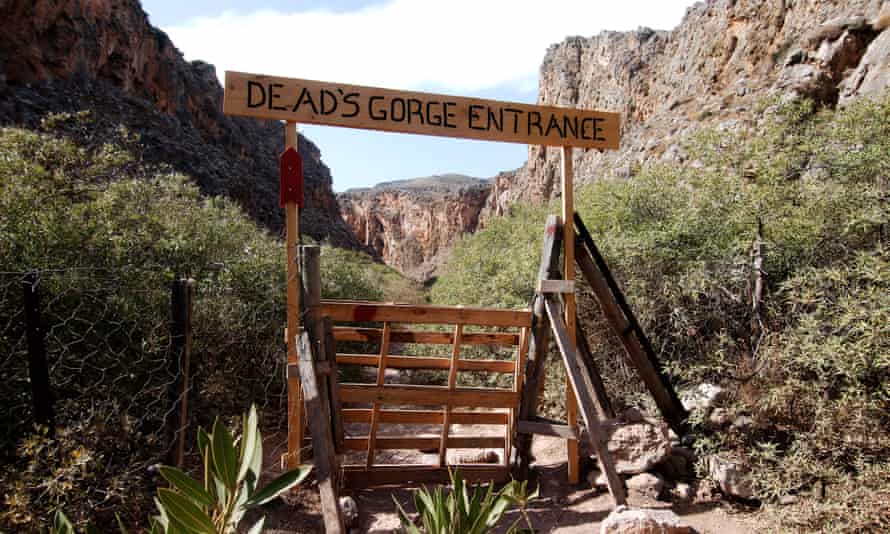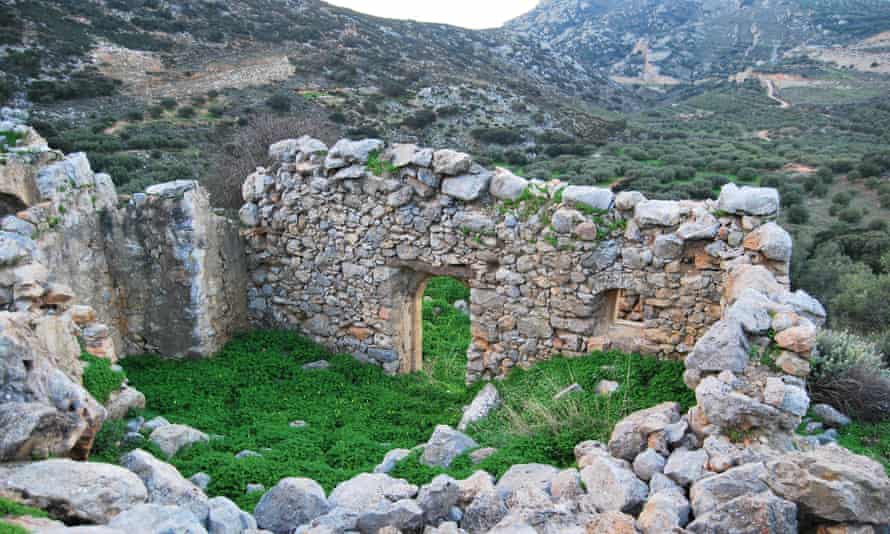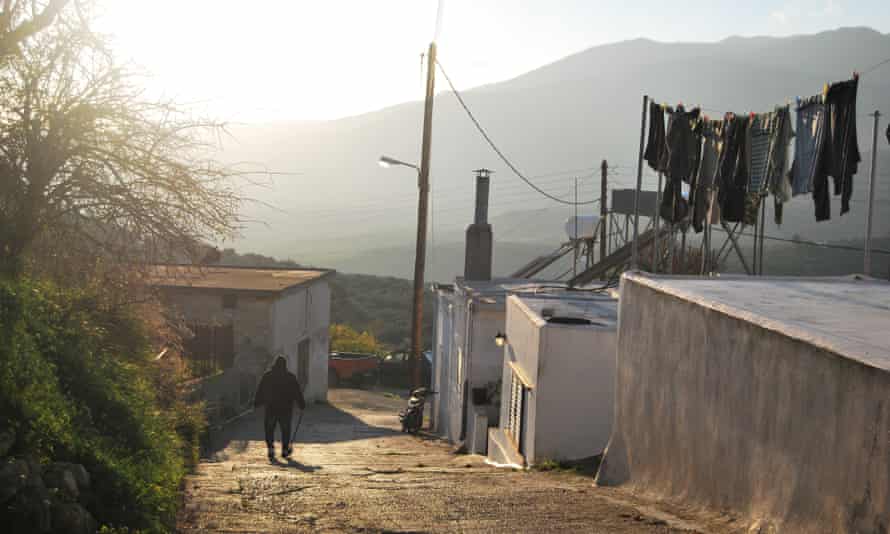Like swirling paper scraps from a bonfire, the charcoal-winged vultures circled high overhead. When I imitated a lamb’s bleat they circled closer, stretching their massive wings and craning long wrinkled necks. The bone-white rocks of the Gorge of the Dead was a fitting backdrop for these pterodactyl-like birds – I could have been in a scene from Jurassic Park.
Named not for the hikers that have perished here (happily none has) but because it’s littered with caves where the Minoans once buried their dead, this seven-mile canyon – also called the Zakros gorge – is the end of the Cretan section of the ultra-long-distance E4 hiking route. The whole trail runs for more than 10,000km from Tarifa in Spain to Cyprus, but this island’s stretch starts 320km away in the north-western town of Kastelli-Kissamos and ends at the remote resort of Kato Zakros.
My plan was to hike a bite-size 35km stretch of the E4 in reverse, from Kato Zakros, near the start of the gorge, to Vóri, a hamlet further south where I would catch a bus back to the port town of Sitia. Far from the doom and gloom of TV and social media and the stress of living in a Covid-stricken world, I would heal my soul – for a weekend, at least – by hiking through untamed landscapes and foragiing for food in one of the wildest corners of Crete.
Packing my old rucksack with fruit, drinking water and a bag of crumbly feta cheese, I set out in early December. Just over 300 nautical miles from Libya and on roughly the same latitude as Cyprus, eastern Crete is almost as warm as Andalucía in winter. In summer and autumn, soaring temperatures can make hiking sticky and unpleasant, but winter means temperatures around 20C, and the sun shining gently in a sky the colour of stone-washed denim.

Leaving the vultures behind, I was soon deep inside the gorge, hiking on a slippery, shale-strewn path between skyscraper-high cliffs. Apart from the drone of bees in the late-flowering thyme and the fierce whistle of a golden eagle somewhere on high, the silence was absolute. The caves where the Minoans once worshipped the souls of their ancestors – and where in later years defiant locals hid from the successive wrath of Venetians, Turks and Nazis – stared down at me like the blankly watchful faces of ancient Greek masks.
After two hours of hard hiking I collapsed on a rock near the top of the gorge and took in the view. Far below, the once-magnificent Minoan Palace of Zakros, with its remains of marble-pillared halls, shrines and ceremonial pools, shimmered like a mirage above the horseshoe-shaped bay of Zakros. It was from the bay that the Minoans once sailed – boats weighed down with jars of wine, olives and figs – to trade for gold and ivory with Egypt and Syria. It was easy to picture the square-sailed ships setting out from this lonely spot; with little or no tourism and only a handful of inhabitants, Kato Zakros still has a sense of antiquity.
Scrambling up one final, staircase-steep section of gorge I emerged near pano (upper) Zakros: a handful of tavernas and a cluster of square white houses in the Unesco-classified Sitia Geopark. At Hotel Zakros I lunched on fried snails (xochloi bourbouristi) in vinegar, rice-stuffed courgette flowers (kolokithanthi gemisti) and other delicious meze.

Leaving Zakros I followed a winding road – past an old mill and the springs that once fed it – and into a sheltered valley where I found an abandoned citrus grove and filled my pockets with tiny sweet tangerines and waxy-skinned lemons. A buffeting wind that tugged at my pack pushed me up along a track lined with purple heather and out on to the plateau of Mavros Kambos – the Black Plain – named for a bloody skirmish with Ottoman troops in the 16th century.
Black was a misnomer, however: the fertile plain was viridescent with horta, the wild greens that have been a staple of the Cretan diet since Minoan times. I gathered some of my favourites – galatsida (common brighteyes), radiki (dandelion) and agriozohos (golden fleece) – for dinner.
By 6pm when I reached Skalia (abandoned in the 18th century after its inhabitants were massacred by the Turks) the sun was low on the horizon, casting an eerie scarlet light on the old stone houses with their caved-in walls and roofs. Finding a sheltered spot I boiled the horta on my camping stove, drained off the water, added lemon juice and olive oil and ate it with a chunk of feta, enjoying the contrast of salty pungent sheep’s cheese with the tender greens.
It was dark by now – so dark that, apart from the distant glow of a village far below, there was no light at all and stars filled the entire sky. It was breathtaking – like being inside a geodesic dome pasted with millions of glittering snowflakes.

Filled with renewed energy after my vitamin-packed foraged dinner I set off along a flinty path fringed with purple heather to Ziros, where I spent the night at Arismari apartments, a sparkling modern complex in the centre of the village.
With its small square houses – and backdrop of jagged blue mountain, this tiny village 30km from the nearest town seemed incredibly isolated when I woke to bright sunshine the following day. Nikos, who owns the cafe where I breakfasted on toast and local thyme honey, told me that recent DNA tests by a Florida university proved that most of the inhabitants in this Lasithi region are descended directly from the Minoans.
A dirt track – via vineyards that produce the crisp and spicy Assyrtiko wines – led through the tiny mountain village of Armeni and then down along a winding road to Vóri. A fug of wine and woodsmoke told me I was approaching a casani, the copper still where – in winter – Cretans distil grape skins left from winemaking to produce raki.
Manolis, the shepherd who owned the still, handed me a plastic beaker of what looked like spring water. I took a sip and nearly choked on the burning 70% proof alcohol.
Manolis told me he’d lived in Lasithi all his life. I mentioned what I’d heard about the DNA tests. “Eh!” he shrugged and took a deep slug from his beaker. “The Minoans loved dancing, women and raki – of course they were our ancestors!”
I hiked on to the outskirts of Vóri where – with Manolis’s permission – I rolled out my sleeping bag in his olive grove. As I lay back to admire the blazing sky full of stars my head was spinning. It was mostly the raki, but I was also giddy with the joy of escaping – for those 35km – the world of Covid. Yamas!
Kato Zakros is an hour’s drive from Sitia. Buses from Vóri to Sitia take 45 minutes, €2.50 single. Arismari apartments sleep five from €65 a night For the latest Covid advice on travelling to Greece see the Foreign Office website



